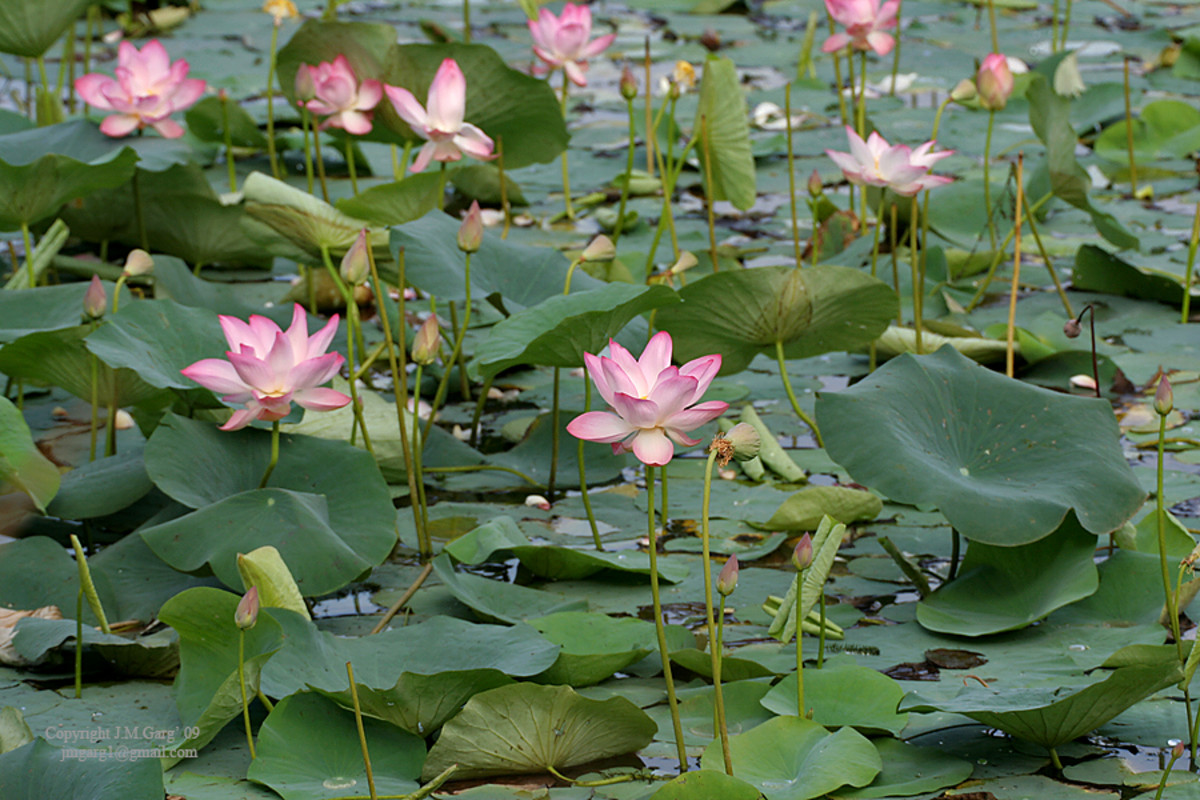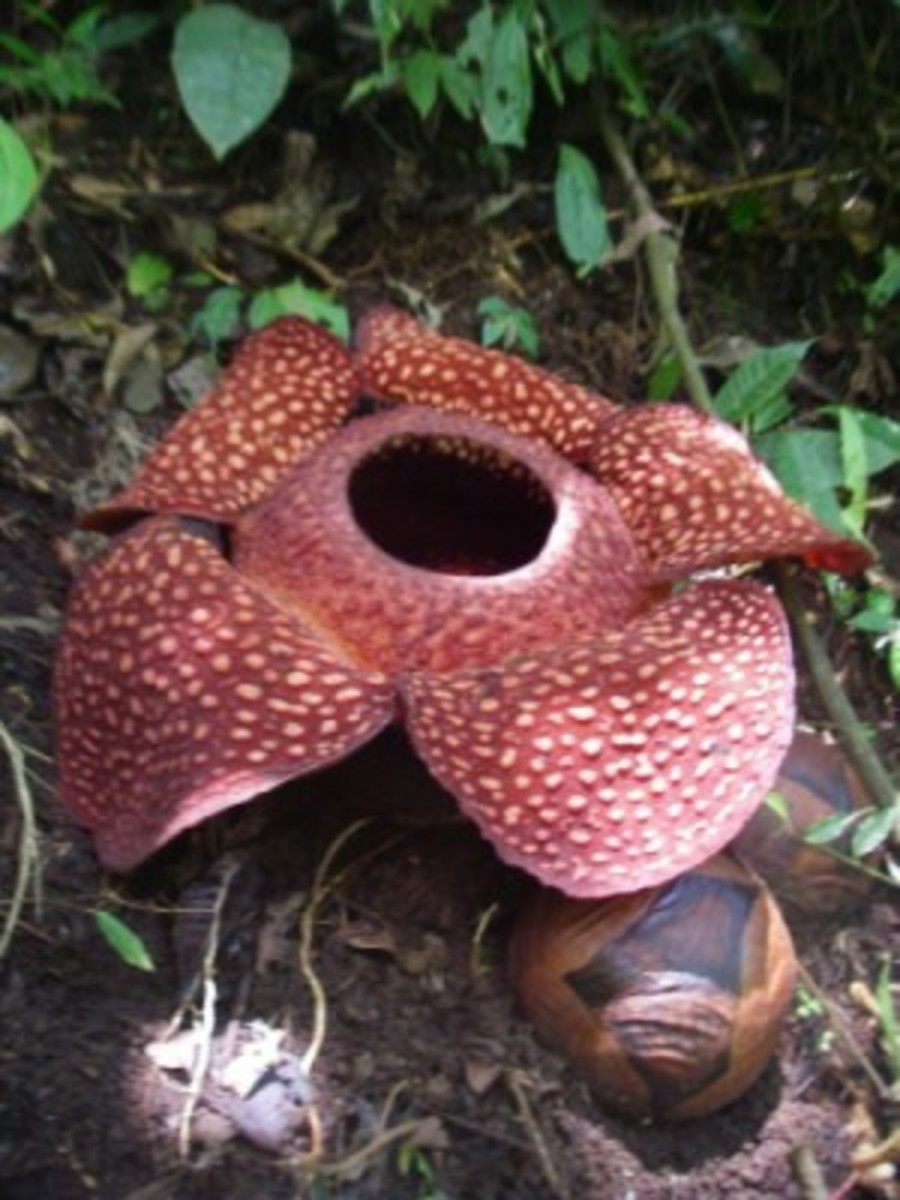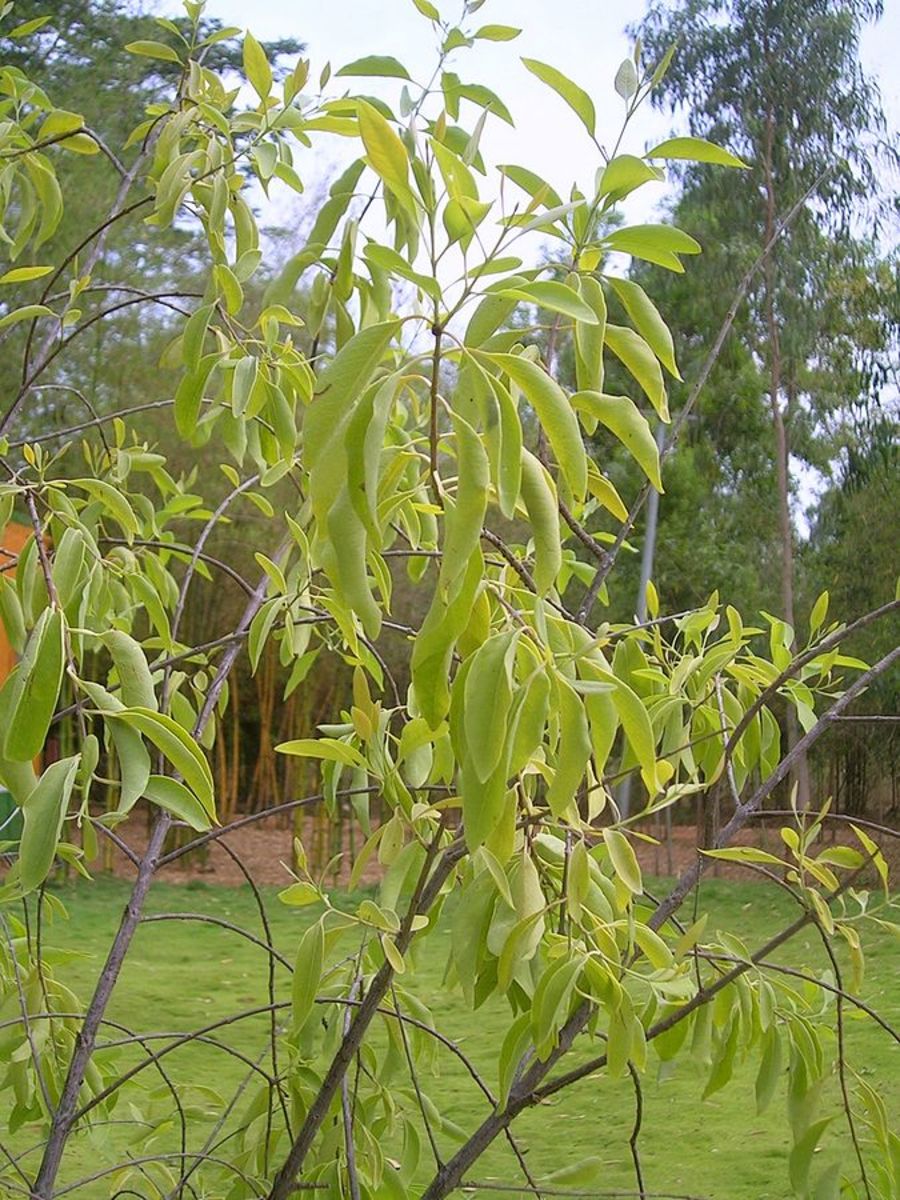Botanical Giants #1: Amorphophallus titanum - The Corpse Flower
I want a giant flower in my back yard that smells like, sweaty feet, putrified onions, and rotting fish. Please, pretty please- Can I Have One?
;-)
With a person next to it for scale
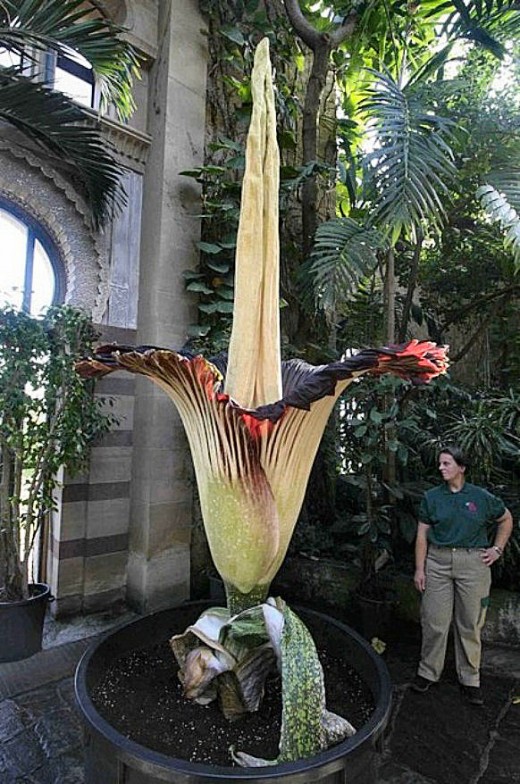
Most people normally, only get to see this plant bloom once in their lives, if ever. This is because the life cycle of the plant only allows it to bloom after many years have passed. In a few places on the internet, you will see quotes, stating that this plant blooms once every 40 or 60 years.
Lately, while being bred under the controlled conditions of a conservatory, it appears to actually bloom a bit more frequently. It will flower as frequently as every 2 years, but from what I gather in my reading on it thus far, that is actually fairly fast for this plant. But, more often, in general or out in the wild, it appears to bloom every 7 to 10 years.
Years ago, one of my favorite television shows was Sir - David Frederick Attenborough's "Life on Earth" series. It is HE who re-named this species of flower as "Titanum arum" for the benefit of his shows, he felt it was inappropriate to use even the original Latin name of the plant. His series, "Life on Earth", was first broadcast on PBS, and was an absolutely fantastic and well-done series regarding the explanation of the evolution of life on Earth. David, is a brilliant and absolutely intelligent individual who is gifted with the ability to make the complex, understandable to the public. If you are marginally educated on this topic (evolution) and then view David Attenborough's show... I guarantee the proverbial "Light-bulb" will go on over your head, and you will say "Ah! I see!". Sir David Attenborough's highly rational explanations and dialogue are clear, sanguine, and focused to achieve understanding. After viewing the series you will walk away edified, and enlightened and positively sure with regard to Life on Earth, and it's morphology as it fits into the grand scheme of time and evolution of life.
Here, ( at the end of the article ) below, is a video clip from one of David Attenboroughs television shows. In it, he introduces a different type of corpse-flower. Nonetheless, it is still a strikingly huge flower, but is from a parasitic plant, not of the style this article is centered on. I'd merely like you to see/hear David Attenborough, at work "doing his thing".
But, for now, back to the corpse-flower.
Meet Todd Brethauer of the U.S. Botanic Garden (below)
He's a volunteer performing the service of public education for the crowds.
And here, directly below, he speaks on the stinky chemistry of the corpse flower. Sweaty socks, rotting onions and putrid fish. Now THAT's a flower I want in MY back yard!
Dimethyl Trisulfide (rotting onions) - and - Trimethylamine (rotting fish) - Isovaleric Acid - (sweaty socks and feet) ...Lovely, eh?
When in it's "vegetative" state, it has ONE single leaf
Just as when it flowers, it has only ONE flower, and no other parts (visible). When it is simply gathering energy and growing, it has exactly ONE gigantic "leaf".
When you looked at the video above, you probably heard Todd say "it has one leaf". But you saw it and thought, "no it doesn't, it looks like several leaves". So if you were confused by that statement and the pictured "leaf", I gathered stills to show you. First, I begin with the "stem" of the leaf. Just showing you a close-up of the stem first. Then after that, are pics that show the top of the stem, where the leafs functional surface area is.
As you look at these pictures, and you get to the "top of the stem", and you witness what appears to be "leaves"... think of it's structure in the following fashion. What appears to be "stems" or stalks, perhaps are better thought of as "veins" similar to the veins in a typical leaf you see on any tree or plant. It's just that, in the case of this particular plant, the leaf is not "filled-in" between the veins. What you are seeing is leaf-tissue, bordering the veins, of the leaf. It IS, indeed, ONE Singular Leaf. One gigantic leaf, like the plant has ONE gigantic flower also.
Well... actually, if you DO get technical, it has ONE Gigantic "flower-structure". But that "flower-structure" is comprised of several flowers (inside the structure) all radially oriented, as an "inflorescence".
To the left of Todd, the leafy "parasol"? is the Leaf

Here is a close-up of the leaf's stem, midway up the stalk
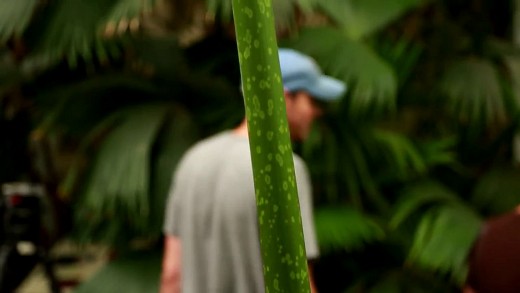
Here, at the top of the stem, you see the veins branch off
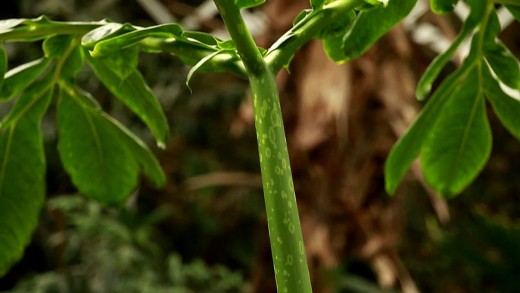
This is just a single giant leaf, which is not filled in, between veins
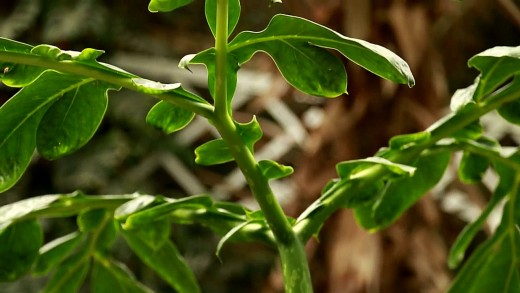
David Attenborough - introducing "His" Titanus Arum
According to Sir Attenborough, it was not popularly known HOW this plant got pollinated, until they directly observed which insects swarmed this particular flower. From what I have gathered, this was probably the first time this flower was truly publicized in America, in some form of modern "mass-media".
The Calla Lily, or Peace Lily - (Aethiopica)
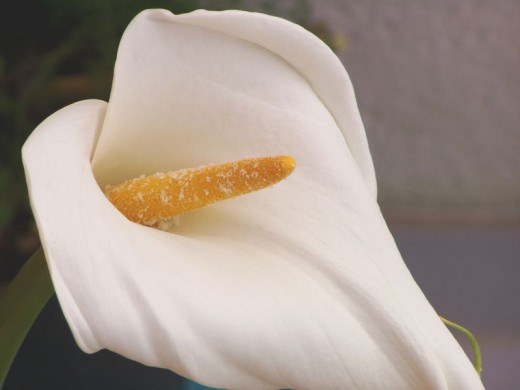
Dracontium spruceanum
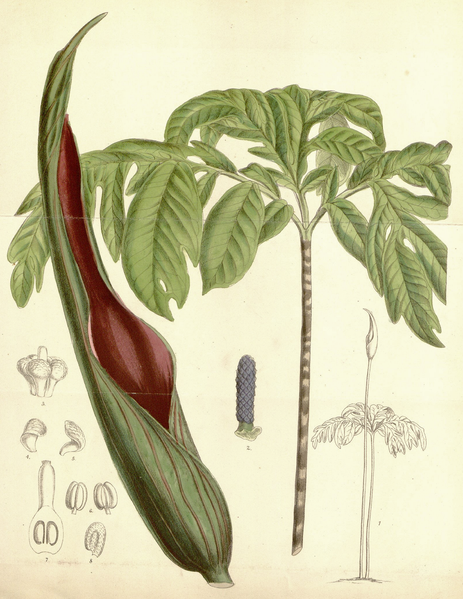
Several subspecies exist
Many of these Amorphophallus plants are giant. But the largest is the titanus species of the genus Amorphophallus. The flower can be ten feet tall. The plant in leaf with no flower can be 20 feet tall. It can weigh over 150lbs, and lasts only about 3 days. And it smells by all accounts, exactly like rotting flesh. This scent, is to attract insects which pollinate it, flesh-flies, and carrion-beetles. The deep red color and texture of the inflourescent bloom, add to the the illusion that this is a piece of meat. During actual blooming, the tip of the spadix is approximately human body temperature, and assists with the illusion of it being a carcass.
All of these similar flowers obtain their name from the prominent spadix of the blossom, which is labeled the "phallos", which is "Amorpho" meaning either "without form" or is "misshapen", with reference to it's large size.These are tropical lowland plants that do not exist naturally in the America's at all. Although the America's DO have a genus that is very similar to the Amorphophallus, called Dracontium, see the example picture.
The plant is normally very slow to bloom. I have seen estimates on the web that state it will bloom only every 40 or 60 years. But, in reality it seems to bloom more rapidly, perhaps when it is cultivated in a greenhouse, at optimal conditions. It is observed to bloom every 7 to 10 years on average. Some plants may bloom every 2 to 3 years. Rarely, it will bloom "back-to-back" one flower after another. And once "bloomed", the flower only lasts about 2 days, remaining open for 24 to 48 hours... until the next bloom.
Behind THIS flower, and to the right. Another vegetative titanus
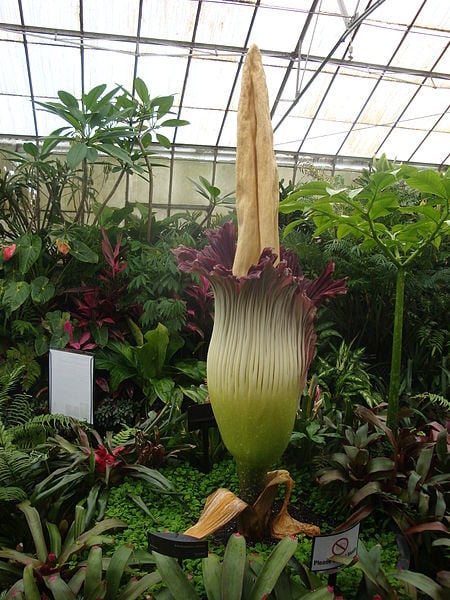
Konjac
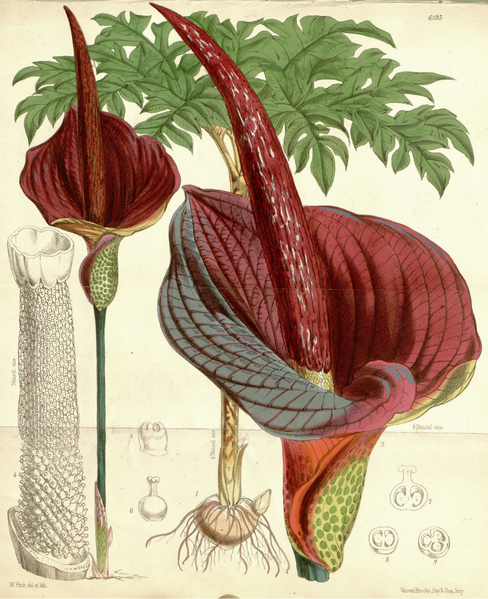
Amorphophallus konjac: is used for food in Japan
The style of root these plants have is called a "corm" which for konjac, can be 25 centimeters in diameter. We know the food by the name, konnyaku (or Yam Cake). Also, pushing the cake through a grid of sharp blades will make noodles, the type called shirataki.
The corm of the konjac is referred to as a yam, although it is NOT a yam.
The plant is cultivated in China, Korea, Taiwan, Japan and southeast Asia for it's large starchy corms. It is used to make flour and jelly, and is a vegan substitute for gelatin.
Konjac, is a primary constituent in vegan alternatives to seafood. It is added into the animal-product-free versions of vegan: scallops, fish, shrimp, crab- and more.
Konjac, is relatively tasteless, and is valued more for it's dietary physical consistency. It will assume the flavors of other parts added to any recipe. It is added to foods, as highly fibrous and is used to aid in weight loss by altering stomach chemistry in a manner beneficial to your gut-fauna (acidophiles). It is used as a source of jellies, and jellied treats. In Asia, it is very popular as a fruit-jelly snack. In the United States, this food product went through an unfortunate phase of highly publicized choking incidents (possibly fostered and encouraged by the rival food companies whose market-share was threatened by the Asian incursion). There were "several deaths" caused by choking upon the food which was shaped (unfortunately) to plug a trachea perfectly, then be difficult to dislodge, after becoming "stuck".
Note to self- DO NOT SHAPE FOOD LIKE TRACHEA-PLUGS....
Second Note to self- DO NOT INHALE FOOD (just because it tastes good)
How do you think "Life Savers" came about as a candy? People are either stupid enough or unfortunate enough to sometimes (accidentally, of course) inhale food. It'll all kill ya, if ya inhale it... No shock there. I do favor the, 'competing American Company' popularizing the food as "unsafe" - theme. I guess Asians NEVER accidentally inhale food. ...moving right along...
inflorescent plant structure
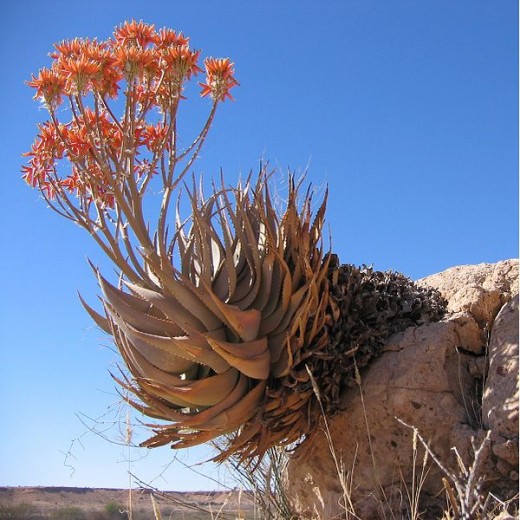
Inflorescent flowers - Like the Calla-Lily or Peace-Lily
They call these flowers "inflorescent". And, I don't know why, but the definitions of this word that you find on the web, seem purposely a bit difficult to comprehend in plain english.
See the smaller pic of the example to the right.
There is a lot of variation on this theme, but, what you see to the right, is a plant with one central axis, and all the petals leaves, stems etcetera, come from that one axis and radiate from that axis, or in the case of a flower... is termed as "in-flourescent", or "flouresces", from that single axis. It is an "inflorescent" flower.
Titanus has ONE Gigantic "flower-structure", that is an inflorescence.
But basically, and to keep it simpler, it all means that the flower and the flowers general plant-structure come from a single central axis. In other words, the plant and flower itself are co-axial, being on (or From) the same axis. The plant overall has a radial geometry, radiating from a single, central axis, as it grows upward or outward.
It has ONE center.
That, is what an "inflorescent" structure is.
On Wikipedia re: Amorphophallus titanum, it says "The titan-arum's inflorescence can reach over 10feet in height." Said another way: "Amorphophallus titanum's, vertical-axis-centered flower may reach a height of ten feet."
Titan Arum in Australia Royal Melbourne Botanic Garden
The time-lapse photography below, is stunning. You can actually SEE how rapidly it grows and changes with each 12 hour period.
I was able to visit Minnesota's botanical garden, I went mainly to walk through their butterfly section. I was there, probably around 2002, this video was done in the summer of 2010 covering July 1 through Junly 21.
Minnesota's Botanical Garden - "I've been there!" !
Minnesota ... to the 26th
Here is Wikipedia's definition of "inflorescent"
- Inflorescence - Wikipedia, the free encyclopedia
I thought that the "essence" of the ACTUAL geometry of the plant was not made directly apparent to a reader who was seeking an ACTUAL definition of "inflorescent"... IN ENGLISH. It's still in geek-speak, in this reference wiki.
Amorphophallus paeonifolius - another subspecies
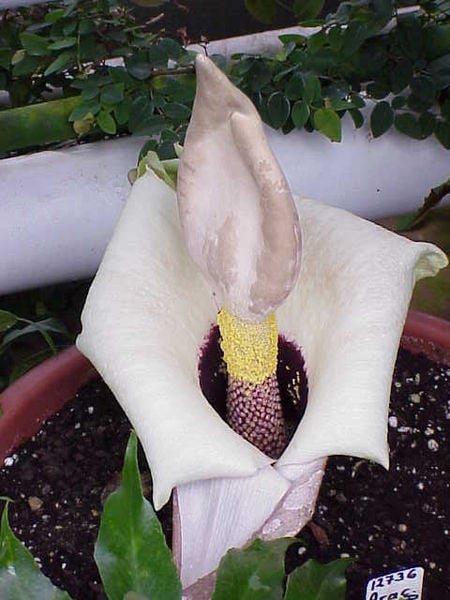
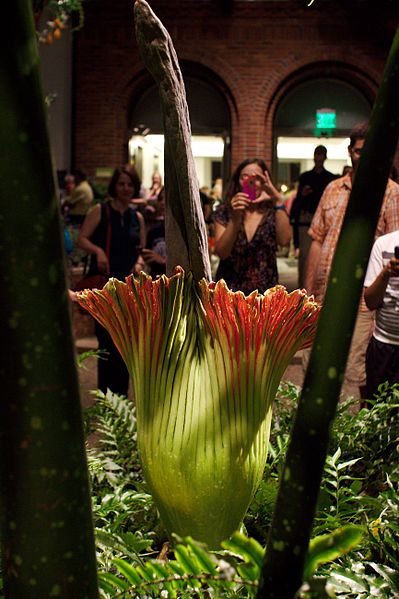
Amorphophallus bulbifer - - yet Another subspecies
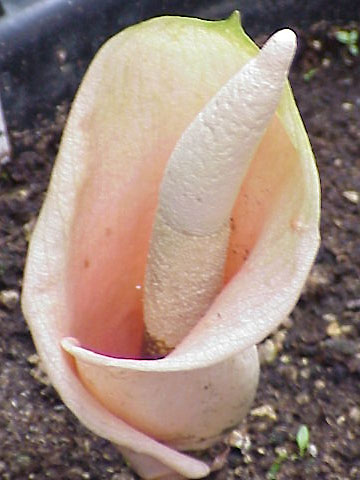
Dominican "Devils Tongue"
It is known by several different food-names. Konnyaku, gonyak, konjac, konnyaku-potato, devils-tongue, voodoo-lily, snake-palm, and elephant-yam. And, there are other names as well. (besides "stinky")
If you are American, it will not grow in your back yard. Unless your back-yard has a nice greenhouse.
What is a " CORM "?
A corm, is an underground root-swelling used to store water and food for a plant that undergoes environmental adversity such as cold, or heat and drought. A corm-root is often referred to as a tuber, or bulb. Sometimes it is a singular "bulb", and sometimes it will be clusters of bulbs, or a bulb-on-a-bulb type of structure.
A Gladiolus corm
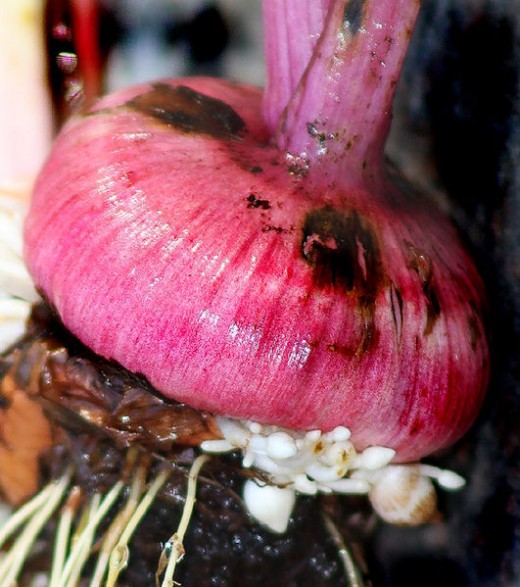
Parenchyma tissue - Corms
Botanists refer to the bulk of a corm as "parenchyma tissue". All that is, is fancy-shmancey talk for "non-woody under-ground-tissue".
The corm of the Amorphophallus, is similar in structure to that of the Crocus or Gladiola, pictured below and to the right.
The corm usually will have a protective layer of some type comprised of a (technically "dead") tunic or skin, often made of a type of leaf, or dead petiole sheaths. This will protect the corm from many insects and even animals. It will also function to help the corm contain it's water despite drier conditions outside the corm. When unearthed and dried, the covering will often appear to be "papery". Like an onion-skin. In some families of plant the corm-covering is quite a physically formidable barrier. Sometimes it is a wood-like layer.
A Crocosmia corm - Crocus
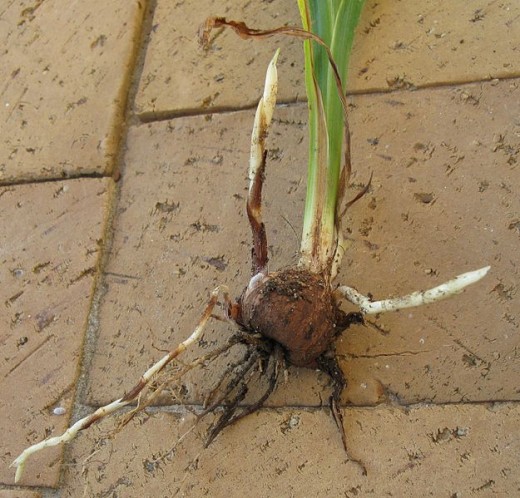
A link to better photos and MORE photos than are on this page
- https://www.facebook.com/media/set/?set=a.726888150663693.1073741841.100000275454253&type=1&
Photos for the article: Botanical Giants #1 - Amorphophallos titanum - the Corpse Flower. There are higher resolution pictures here.
Strawberry Runners - LARGER PICS of all this - on the picture link

I actually have been collecting photos for a couple more rather interesting plants. I've had my eye on some other giants.
I've written an article previously on the "Poke Weed". It's a type of night shade. It's a rather large "weed" itself. I suppose in a way it's a "mini-giant". It's a very huge "weed" that grows about 6 to 8 feet tall, and as high as 10 feet. The stem of that "weed" can be an inch and a half in diameter.
That's a pretty big weed. There should be a few more "Giant" articles coming. Stay tuned.
David Attenborough introduces a different type of corpse flower
Another video of the parasitic Rafflesia Arnoldii, corpse flower
David Attenborough - IMDB and Wiki
- David Attenborough - Wikiquote
"...it seems to me safer to show things that I know to be truth, truthful and factual, and allow people to make up their own minds about the moralities of this thing, or indeed the theology of this thing." -David, believes in the "Truth" of Reality. - David Attenborough filmography - Wikipedia, the free encyclopedia
Davids filmography - very intelligent, good basic stuff. - http://www.imdb.com/name/nm0041003/?ref_=nv_sr_1
David Attenborough on IMDB
Lord Richard in Jurassic Park
HONORABLE MENTION: Richard Attenborough - MOVIE: Jurassic Park
His brother, Lord - Richard Samuel Attenborough, starred in the movie Jurassic Park - 1993, In that movie he played the role of, John Hammond, the parks administrator and primary proponent popularizing the Jurassic concept, and enlisting the aid of venture capitalists and stewarding the Theme Park into existence... which led to the "disaster" of "Man Playing God"... and failing to measure-up to the standards of even a demi-god. This movie was the first time I consciously "noticed" the actor named: Samuel L. Jackson, where he played a very down-to-Earth, competent Engineer, as the general "Systems-Engineer", for Jurassic Park. He actually played the role extremely credibly, as a chain-smoking, "tough-but-smart-guy" I thoroughly enjoyed his role. (After "Jurassic Park", Samuel went on to "Pulp-Fiction" in 1994.) This first "Jurassic" movie, in general, was done very very well. And was true to all topics, fundamentally. Is it any wonder? The names involved with the movie, Jurassic Park, were entirely top-notch. The producers "spared no expense".
Richard Attenborough - IMDB and Wiki
- Richard Attenborough - Wikipedia, the free encyclopedia
Lord Richard, on Wikipedia. - Richard Attenborough - IMDb
Lord Richard Attenborough, Actor: Jurassic Park [role: John Hammond]. Richard Attenborough born in England, the son of Mary (née Clegg), founder of the Marriage Guidance Council, and Frederick Levi Attenborough, a scholar and academic...

